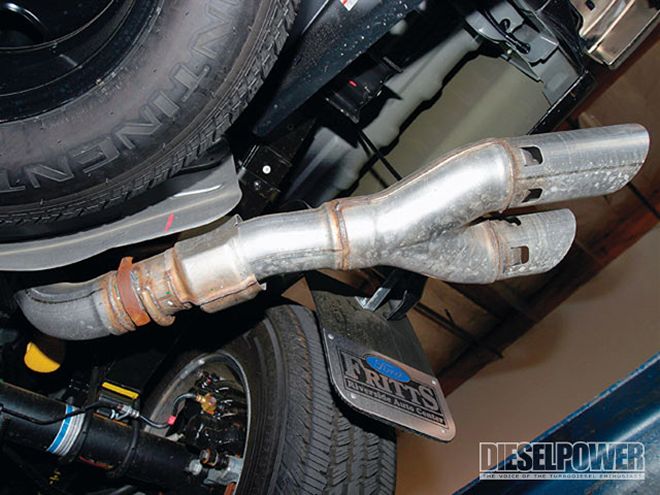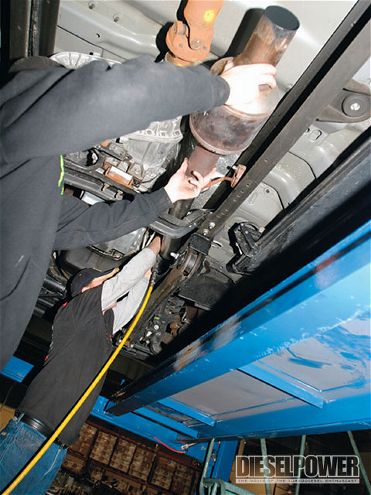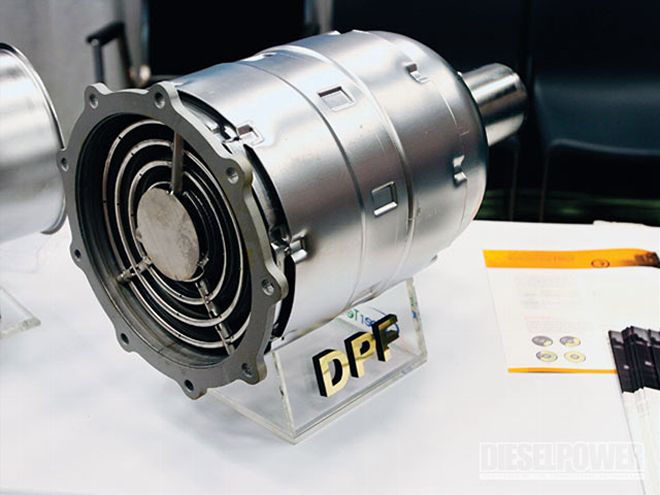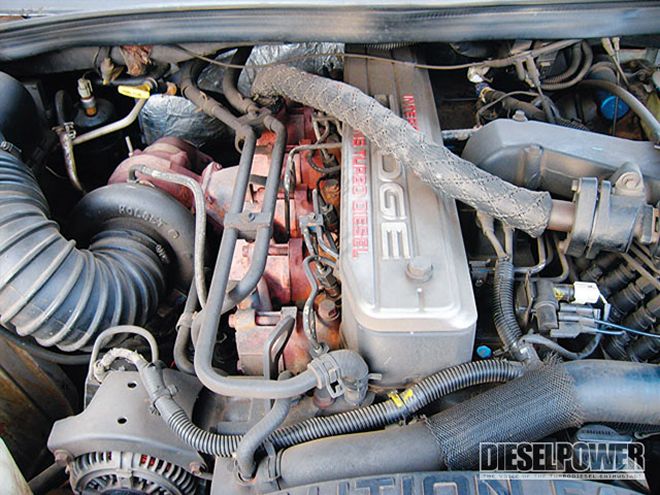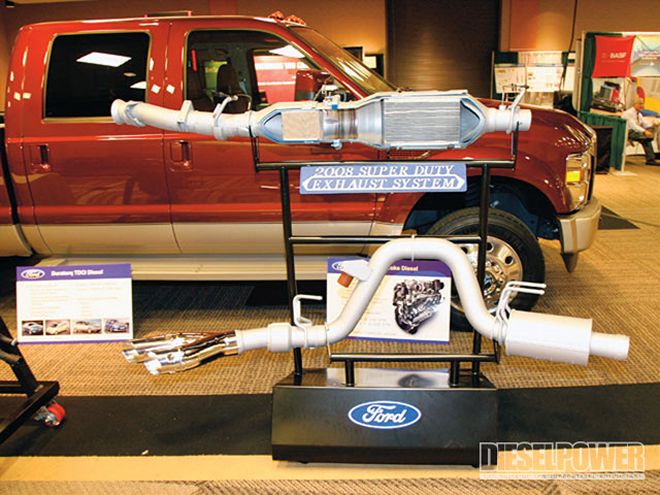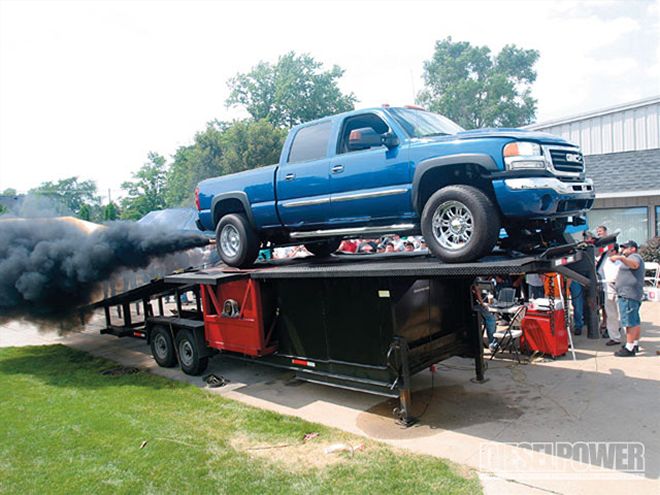
| Tuning can have a dramatic effect on emissions. If you're running 800 hp at the tires like this Duramax is, and trying to spool a large set of twin turbos, then your tune is bound to be a bit smoky. Even without smoke, having advanced timing can raise NOx levels.
As our world moves into a greener tomorrow, emissions regulations for diesels have gotten much stricter. In many states there are still no emissions testing laws for diesel trucks, but prepare for that to change. Diesels have always had to meet certain emissions requirements from the factory, and since the modern diesel pickup's arrival in the '80s, those standards have tightened considerably. In fact, the United States has some of the most stringent diesel emissions standards of anywhere in the world, with California being the toughest of the tough.
In this article we'll explore the basics of the emissions equipment that keeps diesels on our roads. We'll tell you how they work, how they can fail, and how modifying your truck will affect how they function. A normal, good-running diesel will still emit carbon monoxide, hydrocarbons, nitrogen oxides, and particulate matter. All of these pollutants must be taken care of in order to meet modern emissions standards.
CatalystWith all the talk about diesel particulate filters (DPFs), you'd think that diesels never had to go through this before. As far back as the mid '90s, Dodge and Ford fiddled with adding catalysts or EGR systems to their diesel-powered line of pickups. A catalyst changes harmful emissions such as carbon monoxide (CO) and hydrocarbons (HC) to less harmful versions. In the case of carbon monoxide, it is transformed into CO2 (carbon dioxide) and hydrocarbons are turned into H2O (water) and CO2 (carbon dioxide).
DPFWhile catalysts are good at removing carbon monoxide and hydrocarbons, diesel particulate matter (soot) simply passes right through them. To take care of this, all new diesel trucks come equipped with DPFs. To combat soot, DPFs trap particles so the exhaust will exit the tailpipe without any hint of black smoke. However, these trapped particles must be cleaned out of the DPF somehow, or else it will become clogged. To clean the DPF, the engine must go into cleaning mode (often called regeneration, or regen) where fuel is sprayed into the engine very late in the exhaust stroke. This increases exhaust gas temperatures to the point where the excess soot can be almost completely burned off. The downside is the extra fuel burned during regeneration hurts fuel mileage considerably.
EGREGR stands for exhaust gas recirculation and is one of the more common and well-known ways of dealing with nitrogen oxide (NOx) emissions. An EGR system works by directing exhaust gases back into the intake tract of the engine. The hot exhaust gases are used to control the peak in-cylinder temperatures during combustion. When cylinder temperatures get too hot, NOx is formed, but having cylinder temperatures too low can result in power loss and a high content of particulate matter. If EGR sounds like a balancing act, it is. The amount of EGR your engine ingests can vary greatly depending on throttle position. At idle, exhaust gas levels can be as high as 50%. A big downside to EGR is that the recirculated exhaust gases contain very little oxygen, and use up space that could otherwise be occupied by regular air. This brings cylinder temperatures and pressures down, but definitely isn't a help in the power-producing department.
Urea InjectionUrea injection is new to diesels and is aimed at renewing the fuel mileage advantage that diesels used to have over gasoline-powered vehicles. Diesel particulate matter and NOx are trade-off emissions: less NOx usually means more particulate matter, and more NOx usually means less particulate matter. If a way is found to get rid of NOx emissions, then a diesel will create less particulate matter, which means the truck will go into regeneration less often, which means using less fuel. Got all that? Well, urea looks to be leading the charge in the nitrogen oxide-cleaning department. It's sprayed into the exhaust through a small injector, where it releases ammonia, which combines with the nitrogen oxide and is converted into nitrogen and water. Bye-bye NOx, hello fuel savings.
What Happens If I Modify OR Remove Emissions Equipment?It is illegal to remove or modify emissions control devices. But most of the people doing the removing already know that. The second big hurdle is that everything is tied into the truck's computer, which means if anything is tampered with, the computer will start throwing codes. We know of modified Ford, Dodge, and Chevy trucks that have all made more than 400 horsepower at the wheels with the factory emissions hardware intact. On our '97 Dodge, known as Project 12-valve, we picked up only 12 horsepower on the dyno by switching from a stock 31/2-inch exhaust, cat, and muffler, to a 4-inch open pipe. If you are looking to make some serious power, we'd probably opt for clean power adders like water-methanol or nitrous oxide to keep from clogging up your catalyst and diesel particulate filter. If you just absolutely have to make ridiculous amounts of horsepower, there are DPF delete kits and other computer hacks, although in the end you'd probably be better off buying an '06- or-earlier truck.
DP
 | Tuning can have a dramatic effect on emissions. If you're running 800 hp at the tires like this Duramax is, and trying to spool a large set of twin turbos, then your tune is bound to be a bit smoky. Even without smoke, having advanced timing can raise NOx levels.
As our world moves into a greener tomorrow, emissions regulations for diesels have gotten much stricter. In many states there are still no emissions testing laws for diesel trucks, but prepare for that to change. Diesels have always had to meet certain emissions requirements from the factory, and since the modern diesel pickup's arrival in the '80s, those standards have tightened considerably. In fact, the United States has some of the most stringent diesel emissions standards of anywhere in the world, with California being the toughest of the tough.
In this article we'll explore the basics of the emissions equipment that keeps diesels on our roads. We'll tell you how they work, how they can fail, and how modifying your truck will affect how they function. A normal, good-running diesel will still emit carbon monoxide, hydrocarbons, nitrogen oxides, and particulate matter. All of these pollutants must be taken care of in order to meet modern emissions standards.
Catalyst
| Tuning can have a dramatic effect on emissions. If you're running 800 hp at the tires like this Duramax is, and trying to spool a large set of twin turbos, then your tune is bound to be a bit smoky. Even without smoke, having advanced timing can raise NOx levels.
As our world moves into a greener tomorrow, emissions regulations for diesels have gotten much stricter. In many states there are still no emissions testing laws for diesel trucks, but prepare for that to change. Diesels have always had to meet certain emissions requirements from the factory, and since the modern diesel pickup's arrival in the '80s, those standards have tightened considerably. In fact, the United States has some of the most stringent diesel emissions standards of anywhere in the world, with California being the toughest of the tough.
In this article we'll explore the basics of the emissions equipment that keeps diesels on our roads. We'll tell you how they work, how they can fail, and how modifying your truck will affect how they function. A normal, good-running diesel will still emit carbon monoxide, hydrocarbons, nitrogen oxides, and particulate matter. All of these pollutants must be taken care of in order to meet modern emissions standards.
Catalyst